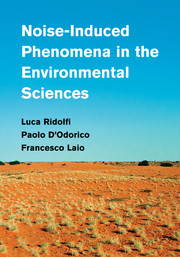Book contents
- Frontmatter
- Contents
- Preface
- 1 Introduction
- 2 Noise-driven dynamical systems
- 3 Noise-induced phenomena in zero-dimensional systems
- 4 Noise-induced phenomena in environmental systems
- 5 Noise-induced pattern formation
- 6 Noise-induced patterns in environmental systems
- Appendix A Power spectrum and correlation
- Appendix B Deterministic mechanisms of pattern formation
- Appendix C List of symbols and acronyms
- Bibliography
- Index
6 - Noise-induced patterns in environmental systems
Published online by Cambridge University Press: 05 August 2011
- Frontmatter
- Contents
- Preface
- 1 Introduction
- 2 Noise-driven dynamical systems
- 3 Noise-induced phenomena in zero-dimensional systems
- 4 Noise-induced phenomena in environmental systems
- 5 Noise-induced pattern formation
- 6 Noise-induced patterns in environmental systems
- Appendix A Power spectrum and correlation
- Appendix B Deterministic mechanisms of pattern formation
- Appendix C List of symbols and acronyms
- Bibliography
- Index
Summary
Introduction
A number of environmental processes exhibit the tendency to develop highly organized geometrical features generally referred to as patterns. For example, in arid and semiarid landscapes the vegetation cover is often sparse and exhibits spectacular organized spatial features (e.g., Macfadyen, 1950) that can be either spatially periodic or random. These patterns exhibit amazing regular configurations of vegetation stripes or spots separated by bare-ground areas. In some cases patterns may spread over relatively large areas (up to several square kilometers) (White, 1971; Eddy et al., 1999; Valentin et al., 1999; Esteban and Fairen, 2006), and can be found on different soils and with a broad variety of vegetation species and life-forms (i.e., grasses, shrubs, or trees) (Worral, 1959, 1960; White, 1969, 1971; Bernd, 1978; Mabbutt and Fanning, 1987; Montana, 1992; Lefever and Lejeune, 1997; Bergkamp et al., 1999; Dunkerley and Brown, 1999; Eddy et al., 1999; Valentin et al., 1999).
Because vegetation patterns are observed even when topography and soils do not exhibit relevant heterogeneity, their formation represents an intriguing case of self-organized biological systems, which results from completely intrinsic dynamics (Lejeune et al., 1999). Self-organization has been also observed in a number of atmospheric and geomorphic processes. Notable examples include the dynamics underlying the formation of ordered systems of clouds (e.g., Krueger and Fritz, 1961), dunes and ripples (e.g., Elbelrhiti et al., 2005; Colombini and Stocchino, 2008; Seminara, 2010; Fourriere et al., 2010), frost boils (Gleason et al., 1986; Krantz, 1990), river meandering (e.g., Ikeda and Parker, 1989), sinuous coastlines (Ashton et al., 2001), or fringed peatlands (e.g., Eppinga et al., 2008).
- Type
- Chapter
- Information
- Noise-Induced Phenomena in the Environmental Sciences , pp. 240 - 268Publisher: Cambridge University PressPrint publication year: 2011



